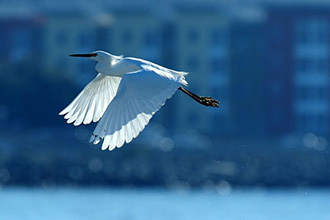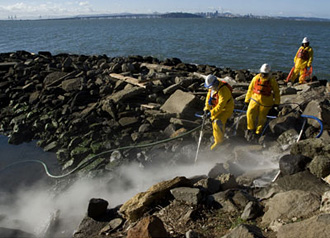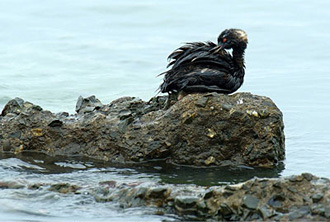University unveils Web redesign
February 8, 2008 -- SF State today rolled out a new Web design template that will provide a visually appealing and unifying design for the University's colleges and departments.
University responds to Cosco Busan spill
December 20, 2007 -- Located just 6.5 nautical miles north of the scene of the Nov. 7 oil spill on San Francisco Bay, SF State's Romberg Tiburon Center for Environmental Studies (RTC) is playing a key role in disaster response efforts. When the Cosco Busan cargo ship collided with a Bay Bridge tower, it spilled nearly 60,000 gallons of fuel oil, which quickly spread to Bay and coastal wetlands and beaches. RTC researchers are working with the government agencies involved in the investigation and cleanup including National Oceanic and Atmospheric Administration (NOAA) and the California Department of Fish and Game Office of Spill Prevention and Response (OSPR).

The usually bright yellow legs of a snowy egret are covered in oil. Photo: Bob Dang, California Fish & Game Office of Spill Prevention & Resonse
RTC Director Toby Garfield responded immediately after the spill and throughout the week that followed by providing state and federal agencies with predictions of the currents and oil movement, based on measuring equipment deployed in central San Francisco Bay and the Gulf of the Farallones. The crew of the Questuary, RTC's research vessel, was dispatched to collect samples of Bay and ocean plants, animals and bacteria throughout the Bay and along the coastline.
Immediately following the spill RTC temporarily shut down the system that fed fresh Bay water into marine labs to avoid contamination and damage.
"Experiments were on hold in the wet lab for several of my students due to either a lack of seawater or lack of access to field sampling sites," Assistant Professor of Biology Sarah Cohen said. "In some cases the sampling materials they had set out in the field were oiled and we were not able to access them due to health and safety concerns." Water samples from the RTC Bay water reservoir were turned over to NOAA.

Workers use high-pressure hoses to dislodge thickening oil from rocks near the Berkeley Marina. Photo: Jonathan R. Gilles, U.S. Coast Guard
Possible long-term damage to the Bay's ecosystem is being investigated from several perspectives. RTC researchers, faculty and students are providing samples, analysis and information to several agencies within NOAA including the Gulf of the Farallones and Cordell Bank National Marine Sanctuaries and the Office of Response and Restoration. Jaime Kooser, manager of the SF Bay National Estuarine Reserve (NERR), based at RTC, is a member of the NOAA's Natural Resource Damage Assessment (NRDA) team for salt marshes, mudflats and coastal lagoons. She is monitoring NERR sites.
Cohen's lab, which examines genomic response of Bay plant and animal species to human influences including contaminants, is providing information on selected invasive and native animal and plant populations in heavily oil-impacted sites within SF Bay and distant sites outside the Bay.
Assistant Professor of Biology Katharyn Boyer is assessing any damage to the eelgrass beds that she had been working to restore in SF Bay. She and her students were trained in Hazardous Waste Operations and Emergency Response (HAZWOPER) in order to participate in the damage assessment within oiled areas. They hosted visits to the Bay by the NOAA eelgrass habitat team, which included academic and agency researchers from San Diego, Washington and North Carolina. Boyer is also sampling Bay water and sediments for hydrocarbon concentration.

An eared grebe struggles unsuccessfully to remove the oil that permeated its feathers. Photo: Bob Dang, Cal. Fish & Game Office of Spill Prevention & Resonse
Adjunct Professor of Biology, Matt Ashby is collecting water samples to profile resident microbial communities to assess the proliferation of marine microbes known to biodegrade petroleum. Postdoctoral researcher Chela Zabin is collecting oysters and sediment for NOAA, RTC and University of California, Davis studies.
"As the only academic marine lab located on San Francisco Bay, we are heavily invested in the health of the Bay," Garfield said. "The expertise of each of these scientists and their work in response to the spill speaks well of the quality of the information RTC will contribute to our national knowledge of the effects of oil spills."
-- Denize Springer
Share this story:
